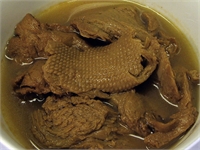
What You Need to Know About Wheat Gluten and Celiac Disease
Important Notice: Our web hosting provider recently started charging us for additional visits, which was unexpected. In response, we're seeking donations. Depending on the situation, we may explore different monetization options for our Community and Expert Contributors. It's crucial to provide more returns for their expertise and offer more Expert Validated Answers or AI Validated Answers. Learn more about our hosting issue here.

What You Need to Know About Wheat Gluten and Celiac Disease
You must be logged in to post a comment.
What is Wheat Gluten, Anyway?
Once the primary source of monosodium glutamate (MSG), the naturally occurring flavor enhancer often associated with food served in Asian restaurants, wheat gluten has for centuries also been used as a food source. Made by washing wheat flour dough until all the starch dissolves, an insoluble elastic mass is left which is then cooked before being eaten.
Also called seitan (as well as wheat meat, Mock Duck, gluten meat, or the “vegetarian white meat,”) wheat gluten has been a staple food among vegetarian monks of China, Russian wheat farmers, peasants of Southeast Asia, and Mormons of the US for centuries. According to Barbara and Leonard Jacobs in their popular cook book Cooking with Seitan, The Complete Vegetarian "Wheat-Meat" Cookbook, people who had traditionally eaten wheat also discovered a method to extract the gluten and create a meat-like product.
Today, in many parts of the world, wheat gluten/seitan is used in place of soybean-based meat substitutes like tofu. Some types of wheat gluten have a chewy and/or stringy texture more like meat than most other substitutes, and is therefore sometimes preferred in Asian, vegetarian, Buddhist, and macrobiotic cuisines (particularly in Japan). Simulated duck made from wheat gluten is readily available throughout Asia, as well as in Asian markets in the US.
Gaining popularity with the vegetarian sector (particularly in the US), gluten is often a key ingredient in “not-dogs” and in many other commercially-made, ready-to-eat products like wheat gluten burgers, sausage-style and chicken-style seitan, as well as fajita strips, and slices. Commercially prepared tubs or vacuum-packed bags of seitan soaking in marinade is readily available, and can also be found in the refrigerator or freezer section of many natural food stores.
What are the Health Concerns Related to Wheat Gluten?
A recent article published in The New England Journal of Medicine listed 55 "diseases" that can be caused by eating gluten, including osteoporosis, irritable bowel disease, inflammatory bowel disease, anemia, cancer, fatigue, canker sores, rheumatoid arthritis, lupus, multiple sclerosis, and almost all other autoimmune diseases.
Additionally, wheat gluten is also linked to many psychological and neurological disorders, including anxiety, depression, schizophrenia, dementia, migraine headaches, epilepsy, and neuropathy (nerve damage), and even autism.
While it used to be thought that gluten sensitivity, or “Celiac Disease,” as it is known, was confined to children who subsequently suffered diarrhea, weight loss, and failure to thrive, studies have now proven that there is no correlation between these factors and gluten sensitivity–and virtually anyone can develop related diseases.
Celiac Disease is actually an autoimmune disease that creates inflammation throughout the body, with wide-ranging effects across all organ systems including the brain, heart, joints, and digestive tract, and can be the single cause behind various types of illnesses.
While, of course, not all cases of depression or autoimmune disease can be traced to gluten consumption, should you be one of those who suffer any chronic illness related to these areas of health, gluten sensitivity should be considered and proper steps taken to eliminate 100% of the gluten from your diet. .
Does this Mean that as Long as I Avoid Asian and Vegetarian Products I Have Nothing to Worry About?
Not at all. Wheat gluten is now a common ingredient in fast foods, processed and pre-packaged foods, as well as a growing number of wheat-related products (you probably have in your homes right now); gluten is turning up in places you might never suspect.
Here is a partial list of common, everyday products and additives that often contain wheat gluten:
> General
Ale/beer
Brown rice syrup
Canned baked beans
Cereal additives
Condiments made with grain distilled vinegar
Cooking sprays that contain grain alcohol 4
Duram
Emulsifiers
Farina fried food in restaurants
Gluten stabilizers
Herbal teas made with malted barley
Hydrolyzed Plant Protein (HPP)
Hydrolyzed Vegetable Protein (HVP)
Modified food starch
Most white pepper
Oat gum
Oils (not pure)
Olestra
Packaged pudding
Some canned tuna
Some cheese spreads and dips
Some commercial candies
Some commercial salad dressings
Some corn syrups
Some ice creams
Some mustard powder
Some preservatives
Some sherbets
> Vegetables
Black- eyed peas, canned
Pepper, chipotle in Adobo sauce, canned
Spaghetti/marinara sauce (check ingredients)
> Legumes and beans
Bean paste (possible preservatives)
Tofu (gluten content varies)
> Starches / cereals
Bagels
Baguettes
Barley
Bran
Biscuits
Bread, white/wheat/rye
Buckwheat
Bulgur
Cornbread, packaged
Couscous
Crackers, saltine
Crackers, graham
Croutons, plain
English muffins
Wheat flour
Hoagie rolls
Melba toast, plain
Malts
Matzo
Millet
Rye
Semolina
Noodles, Ramen
Oats
Pasta, dry
Potato products, frozen
Tortilla, flour, 6-inch
Barley, dry
Cereal, oatmeal
Cereal, Cream of Wheat brand
Cereal, Kellogg’s All Bran Flakes
Quinoa
> Dairy
Cheese, blue (veined cheese)
Cheese, cottage, low fat
Cheese, fontina
Cheese, goat
Cheese, mozzarella, fresh
Cheese, parmigiano-reggiano
Cheese, pecorino-romano
Cheese, ricotta, reduced fat
Cool Whip
Creamers, non-dairy
Egg substitute (may contain unidentified vegetable gums)
Ice cream
Sour cream, non fat
> Fats
Mayonnaise, reduced calorie
Pam vegetable spray
Sour cream, reduced calorie
> Sweets
Chocolate, bakers, bittersweet (gluten-free if pure)
Cocoa, dry, powered (gluten-free if pure, not a mix)
Graham crackers (wheat)
Pie, apple (wheat flour)
Pudding
Sherbet (check ingredients)
Wafer, chocolate (wheat)
For a more complete list of foods containing gluten visit: https://www.drgourmet.com/gluten/containsgluten.shtml)